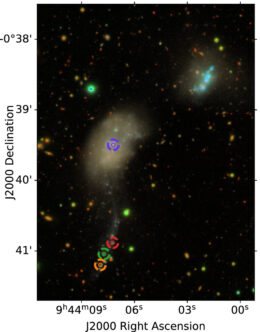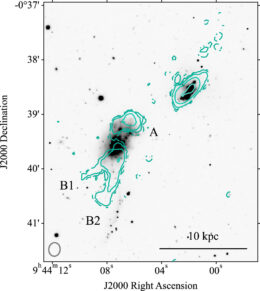Researchers have spotted an unusual pair of interacting dwarf galaxies: one with many bright young stars, the other with none. New research examines how two seemingly similar galaxies can have such different outcomes, shedding light on why quiescent dwarf galaxies are so rare.
A Clash of Small Galaxies

A visible-light and infrared view of UGC 5205 (left) and PGC 027864 (right). [Adapted from Kado-Fong et al. 2024]
Enter UGC 5205 and PGC 027864, a pair of dwarf galaxies that have responded in remarkably different ways to their interaction. PGC 027864 is a typical dwarf starburst galaxy ablaze with new stars, but UGC 5205 is eerily quiet. Previous observations show that the two nearly equal-mass galaxies each contain abundant star-forming gas, making UGC 5205’s lack of new stars a real mystery. Now, new data have solved the mystery of the missing star formation.

Contours from the new Very Large Array data showing the location of neutral hydrogen gas (green) overlaid on a grayscale optical image. [Kado-Fong et al. 2024]
A Close Look at Cold Gas
Erin Kado-Fong (Yale University) and collaborators collected new observations of the interacting galaxy pair with the radio dishes of the Very Large Array. These new high-resolution observations show that while UGC 5205 contains an adequate amount of star-forming fuel, most of it has been expelled from the main body of the galaxy into three tidal structures. PGC 027864’s gas, on the other hand, looks mostly normal, with just a small tidal tail. While the reason for the different behavior isn’t clear — perhaps PGC 027864’s gas was more concentrated — this shows that UGC 5205’s star-formation shutdown is due to a lack of neutral hydrogen gas.
How long ago did this rare quiescent dwarf galaxy’s star formation shut down? Optical and ultraviolet images of the galaxy pair show that though UGC 5205 shines brightly in the ultraviolet, indicating abundant star formation on the order of 100 million years ago, it’s invisible at optical wavelengths that trace star formation in the past 10 million years. By modeling the light emitted by different populations of stars, Kado-Fong’s team found that UGC 5205 likely underwent a quenching event 100–300 million years ago.
Quiescent for Now

The star formation rates and masses of the two galaxies in this study compared to low-mass galaxies on the star-forming main sequence. The two galaxies have similar rates measured from ultraviolet (UV) light, which traces star formation on the order of 100 million years ago, but dramatically different rates measured from Hα, which traces star formation in the last 10 million years. [Kado-Fong et al. 2024]
Citation
“Dwarf–Dwarf Interactions Can Both Trigger and Quench Star Formation,” Erin Kado-Fong et al 2024 ApJ 963 37. doi:10.3847/1538-4357/ad18cb
